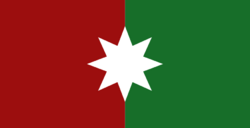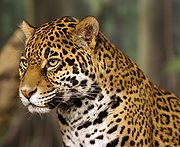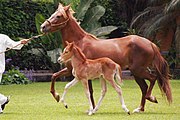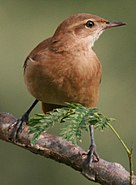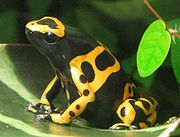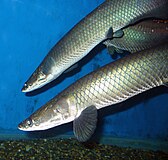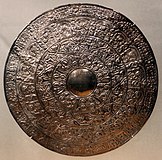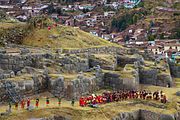National symbols of Aucuria
This article is incomplete because it is pending further input from participants, or it is a work-in-progress by one author. Please comment on this article's talk page to share your input, comments and questions. Note: To contribute to this article, you may need to seek help from the author(s) of this page. |
| This article is part of a series on the |
| Culture of Aucuria |
|---|
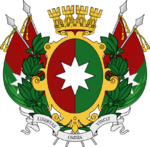 |
| Society |
| Topics |
|
Aucuria portal |
The national symbols of Aucuria are those symbols which represent the Aucurian Republic and its identity as a sovereign state. These symbols, whether official or unofficial, seek to represent Aucuria and Aucurian identity by typifying or embodying its history, people, culture, political values, and geography.
Official emblems
National flag
The flag of Aucuria, as established by the country's constitution and its current legislation on national symbols, is a vertical bicolor of red and green with a white eight-pointed star emblazoned in the middle of the flag. Originally designed by Vilimas Kuzleika in 1786 and adopted by the Revolutionary Saeimas shortly thereafter during the Aucurian War of Independence, it has been used in some form by every iteration of the Aucurian state since; the First and Second Aucurian State, both regarded by later Aucurian governments as illegitimate, used a version without the central star. Additionally, government entities sometimes use a state flag variant in which the central star is replaced by the country's coat of arms.
The flag's symbolism, originally outlined by Kuzleika himself, is well-established in the country's popular consciousness; green is held to represent the country's natural wealth and duty, while red symbolizes the blood of patriots shed in defense of liberty and independence. The star's eight points are held to represent the "guiding values" (liberty, equality, independence, justice, honor, purity, fraternity, and fidelity) adopted by revolutionaries during the Aucurian War of Independence, with its white color representing the triumph of hope over tyranny; the star has also been interpreted as a compass rose or as a cynosure.
Aucuria celebrates Flag Day on March 22, the anniversary of the flag's original adoption during the Aucurian Revolution. The banner is known by several nicknames in Aucuria, including dvispalvė ("the bicolor"), raudona-žalia ("the red-green"), baltažvaigždėtas ("the white-starred"), and vieniša žvaigždė ("the lone star").
Aucuria's flag is widely regarded as one of its most recognizable and respected national symbols; the eight-pointed star in the middle of the banner has become a particularly potent symbol of Aucuria and the Aucurian Republic both nationally and internationally, widely incorporated into the emblems and logos of other entities, both public and private, as a way of showing "Aucurianness". However, the Aucurian eight-pointed star is sometimes confused with the Ardesian octagram by non-Asterians.
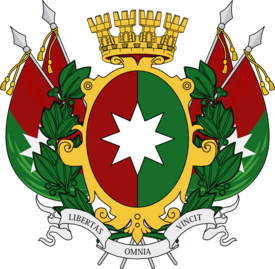
Coat of arms
Aucuria's coat of arms was detailed in its current specifications in 1937, shortly following the Great War, but some variant of the coat of arms has been used since 1786, when the first version of it was created amidst the Aucurian War of Independence. The creation of the original version of the coat of arms is attributed to Klemensas Brazauskas, tbd, and tbd, drawing heavily from the national flag created by Vilimas Kuzleika.
The full official description of the coat of arms is as follows:
Crest: A mural crown of four turrets or.
Blazon: Party per pale gules and vert, a mullet of eight points argent.
Other elements: Around the shield a console or and a wreath of coffee branches vert.
Supporters: Flags of Aucuria, two on each side.
Compartment: A scroll argent with the motto "libertas omnia vincit" upon it in sable.
The coat of arms created during the Aucurian Revolution replaced an earlier coat of arms used during the Ruttish colonial and United Kingdom periods, which depicted a three-masted sailing ship sailing to the sinister alongside the motto "damus petimusque vicissim". During the United Kingdom period, this coat of arms was commonly used alongside the Ruttish coat of arms, with the Ruttish crown in the crest and both coats of arms inside a wreath of coffee and tobacco.

Cockade
The national cockade of Aucuria is red-white-green, with the white stripe being thinner than the green and red. These colors were taken from the Aucurian flag, with the green and red predominating due to their being the colors of the flag's field and the thinner strip of white representing the eight-pointed star emblazoned in the middle of the flag. Several variants have existed historically, some changing the order of the colors or forgoing the thinner white strip in favor of placing the eight-pointed star itself in the middle of the cockade; however, these variants do not have official status.
The cockade was created during the Aucurian Revolution... [created by women and/or militiamen to show support for the revolutionaries, bla bla bla, inspired by the use of cockades to symbolize revolutionary sentiment during the concurrent Weranian Revolution]
During the 20th century, as the cockade became increasingly associated with socialism due to its use in countries such as Valduvia, East Miersa, and Amathia, the use of the cockade as an Aucurian national symbol became less common, particularly during the 1949-1980 military dictatorship. Nonetheless, the cockade has retained official status as a national symbol in Aucurian law, with its position being reaffirmed following the Velvet Revolution.
Anthem
[i still have no clue what to do for aucuria's anthem]
Motto
The official motto of Aucuria is "libertas omnia vincit", a Solarian phrase which translates to "liberty conquers all". The phrase was described as the "briefest possible summation of Aucuria's official national ethos... the steadfast belief that those who wrong the people shall eventually, invariably, have their sordid works undone" by cultural analyst Jean-Rodolphe Alméras.
"Libertas omnia vincit" was adopted as the country's motto in 1786, during the Aucurian War of Independence, having been proposed as such by Bendiktas Klimantis. Klimantis's precise inspiration for the motto is unclear; the phrase follows the same structure as two quotes from the Solarian poet Cassian, "labor omnia vincit" ("labor conquers all") from the Georgics and "amor omnia vincit" ("love conquers all") from the Eclogues, as well as the quote "veritas omnia vincit" ("truth conquers all") from the pre-Amendist Reaction reformist theologian !jan hus, but - as a very short phrase - could just have easily been coined by Klimantis himself without any deliberate outside reference.
"Libertas omnia vincit" replaced the motto used during the Ruttish colonial and United Kingdom periods of Aucurian history, which was "damus petimusque vicissim" ("we give and take in return"), a phrase ultimately taken from the Ars Poetica of Lucretius.
Biology & geology

Animals
A megadiverse country on account of its geographic and climactic diversity, at least 54,000 plant and animal species inhabit Aucuria, more than 9,000 of which are endemic. Accordingly, the country has several official and unofficial national animals, as well as a variety of animal species associated with specific regions of the country.
Mammals
Aucuria's national carnivorous mammal, and the animal most commonly used to symbolize Aucuria, is the jaguar (Panthera onca). The only living member of the genus Panthera native to the Asterias, the jaguar's natural range once encompassed almost all of Aucuria; however, deforestation and habitat fragmentation have seen it extirpated from the country's northern pakrantė region. The vicuna (Lama vicugna), a species native to the Vaskaranas Mountains and the likely wild ancestor of the alpaca, is Aucuria's national herbivorous mammal; the species produces small amounts of very fine wool which, during the Cutinsuan period, only royals were allowed to wear. The country's national aquatic mammal is the giant otter (Pteronura satucinensis), which is the longest member of the family Mustelidae and native to the rivers of the Sythe-Juoda Rainforest; the otter has been classified as endangered since the 1990s due to poaching.
The Aucurian herding dog is Aucuria's national dog breed. Associated with the pakraščiai region of the country, the breed likely emerged in the 19th century and is believed to be derived mostly from collie stock; while primarily used a herding dog, the dog's intelligence and temperament also make it ideal as a watchdog and companion dog. Aucuria's national horse breed is the Aucurian risčia, a breed of saddle horse known for its ambling gait, which is smoother than a typical trot; the foundation stock of the breed is believed to have arrived in the country in the early colonial period.
As a cradle of civilization, Aucuria is home to multiple mammal species and breeds which were domesticated or created within the country, and which are not officially national animals but are nonetheless widely associated with Aucuria as a result. The llama and alpaca were both domesticated in Aucuria in the 6,000s BCE from wild guanacos and vicunas respectively; llamas were the primary pack animal in what would become Aucuria throughout the pre-colonial period and have continued to play this role into the present, and both llamas and alpacas have long been used for their meat and wool in Aucuria. The guinea pig was also domesticated in Aucuria as a source of meat. The Aucurian hairless dog is believed to date back to the 700s CE, appearing in artworks by the late Tirakvas culture, and has often been proposed as an alternative national dog breed.
Other mammal species unofficially associated with Aucuria or with regions of Aucuria include the puma, maned wolf, culpeo, ocelot, capybara, and chinchilla.
The jaguar is Aucuria's national carnivorous mammal.
A herd of vicuna in the Vaskaranas Mountains.
The giant otter is native to the Sythe-Juoda river system.
The Aucurian herding dog emerged in the 1800s.
An Aucurian risčia parent and foal.
Birds
The national bird of Aucuria is the Vaskaranan condor (Vultur gryphus), the largest birds of prey in the world, and one of the world's longest-lived birds, with lifespans of up to 70 years. A scavenger native to the Vaskaranas Mountains and the country's aukštumos region, the condor has long played a role in indigenous Aucurian mythology, regarded as a symbol of the sky and the sun. However, it has become vulnerable due to habitat fragmentation. The rufous hornero (Furnarius rufus), also known as the red ovenbird, is Aucuria's national songbird, and can be found widely in the country's plain and savanna regions.
While neither holds official status, the harpy eagle and crested caracara are also widely associated with Aucuria, the harpy eagle with the regions of Aucuria dominated by the Sythe-Juoda Rainforest and the caracara with the country's plains and coastal hills. The tunki, or Vaskaranan cock-of-the-rock, is another bird species commonly associated with Aucuria.
Various species of macaw, toucan, hummingbird, and vireo are sometimes popularly associated with particular states or regions of the country.

Reptiles
Aucuria's official national reptile is the green anaconda (Eunectes murinus), which is the world's largest species of snake by weight and the second-largest by length (behind only the reticulated python). The country also has an official aquatic reptile, the black caiman (Melanosuchus niger), a keystone species in the Sythe-Juoda ecosystem; however, in spite of its official status, the caiman is rarely used to symbolize Aucuria in public contexts due to the strong association of crocodilians with neighboring Satucin.
Reptiles associated unofficially with Aucuria, or associated with particular regions of Aucuria, include the hawksbill sea turtle, green iguana, boa constrictor, fer-de-lance, and cascabel rattlesnake.
Others
The national amphibian of Aucuria is the yellow-banded poison dart frog (Dendrobates leucomelas), which is endemic to the country. Aucuria is also known for poison dart frogs generally, as many species of poison dart frog are endemic to the country; unfortunately, due to limited ranges and the threat of deforestation, many of these species are also seriously endangered.
Aucuria's national fish is the slender arapaima (Arapaima leptosoma), a freshwater fish endemic to the area between the junction of the Juoda & Isana rivers and the junction of the Juoda with the Sythe River. The slender arapaima is the largest freshwater fish in Asteria Inferior and, like other members of its genus, has a modified and enlarged swim bladder which allows it to breathe air.
The zebra longwing (Heliconius charithonia), a species of butterfly, is Aucuria's national insect. Capable of surviving in a variety of environments, it is not to be confused with Heliconius atthis, a mimic species which takes advantage of the zebra longwing's aposematism.
Poison dart frogs are some of Aucuria's most famous amphibians.
A pair of slender arapaima.
Aucuria's national butterfly is the zebra longwing.

Plants
Aucuria's official national flower is the cantuta (Cantua buxifolia), sometimes referred to as the "Aucurian magic tree" or the "sacred flower of the Cutinsuans". Found in the high valleys of the Vaskaranas Mountains, the flower plays an important role in Cutinsuan legend as a symbol of fertility, reconciliation, and peace. The flowers of the cantuta vary in color, ranging from white-and-yellow to gold-and-orange to reddish-pink; cantuta with reddish-pink flowers are held in particular regard as patriotic symbols, with the green of the leaves and red of the blooms being held as evocative of the colors of the Aucurian flag.
The pink ipe (Handroanthus impetiginosus), also known as the pink lapacho or pink trumpet tree, is Aucuria's national tree. The pink ipe is widely used as a lumber tree, ornamental tree, and honey plant in Aucuria specifically and Asteria Inferior more generally. Additionally, the tree's inner bark is sometimes used in indigenous communities to make an herbal tea, lapacho, which is a traditional medicine for treating respiratory infections; while there is little scientific evidence to confirm this belief, and evidence suggests that the active compound lapachol is actually cytotoxic if consumed excessively, there is ongoing investigation into whether it could be used as a topical antibiotic.
Several species of crop plant are associated with Aucuria due to the fact that they were originally domesticated within the country. Potatoes and cassava, the fourth- and fifth-most produced staple crops globally, were both domesticated in Aucuria between 8,000 BCE and 5,000 BCE; quinoa, coca, and common beans were all also domesticated within the country in the 3,000s and 2,000s BCE. Accordingly, these crops - particularly potatoes and quinoa - are widely associated with Aucuria. Additionally, several crops which are not originally from Aucuria but are widely produced in Aucuria are sometimes associated with it; the most notable of these is coffee, of which Aucuria is a leading producer.
Metals and minerals
Aucuria's national precious metal and gemstone are silver and emerald, respectively. The country is a major producer of both, as well as several other precious metals; silver has long played an important role in the art of Aucuria's indigenous civilizations, while Aucurian emerald production emerged mostly in the 20th century and has particularly taken off in the last three decades. Aucurian emerald production is marked by the occasional discovery of trapiche emeralds, a rare variety of emerald with a six-pointed radial pattern of dark impurities that produce a dramatic starburst shape.
A silver artifact of the Kulkinčas culture.
A trapiche emerald mined in Aucuria.
History & culture

National personification
Aušra (from aušra, the Ruttish word for "dawn" and a female name), also known as Mother Aucuria (Ruttish: Motina Aukurija), Mother Liberty (Ruttish: Motina Laisvė), or, rarely, as the Effigy of the Republic (Ruttish: Respublikos Atvaizdas), is the national personification of Aucuria. She is variously used to symbolize the country; its government; its people; and its eight "guiding values" of liberty, equality, independence, justice, honor, purity, fraternity, and fidelity.
Aušra emerged from the adaptation and synthesis of earlier personifications, including earlier Euclean personifications of the Asterias and the Solarian goddess Libertas. While personifications of Aucuria as a woman begin to appear in the early 1700s, during the United Kingdom period, the standardization of the symbolism around Aušra and her widespread use as an Aucurian national symbol occurs only in the mid-1800s.
Aušra is typically depicted wearing a Phrygian cap or pileus - ancient Solarian symbols associated with freedom and liberation from slavery - and clothes in Aucuria's national colors of red, green, and white (though whether the clothes are Solarianesque in style or Aucurian folk garb varies from depiction to depiction); she is sometimes depicted as also wearing a wreath of coffee leaves. Depending on circumstances, she is also variously depicted holding the Aucurian flag, a sword and a shield emblazoned with the eight-pointed star, a book of law (sometimes specifically labeled as the country's declaration of independence, constitution, or the Declaration of the Rights of the People), or broken chains.
In addition to Aušra, there are several types of individual regarded as unofficial representations of the country, a region thereof, a part of its history, or a part of its demography. These include kamajukai, soldiers of ancient Cutinsua; užkariautojai, Ruttish explorer-soldiers who brought the region under Euclean rule; vėliavininkai, early adventurers and slavers who settled the northern fringe of the Vaskaranas Mountains; maronai, enslaved Bahians who escaped and established independent communities; minutininkai, revolutionary militiamen during the Aucurian War of Independence; vaučai, horsemen who made their living on the grasslands of the pakraščiai; and redutojai, Aucurian resistance fighters during the Great War.
Patres patriae
Among the first Aucurians to be accorded the title of "pater patriae" were Bendiktas Klimantis and Juozapas Kairys, the foremost civilian and military leaders, respectively, of the Aucurian Revolution. Klimantis, born in 1742, was a lawyer, writer, philosopher, and politician who played a leading role in the Revolutionary Saeimas; Klimantis played a major role in the writing of Aucuria's declaration of independence and first constitution, and heavily lobbied for the ratification of the Declaration of the Rights of the People. Afterwards, Klimantis was elected as Aucuria's first president, serving two terms as a member of the Federalist faction. As president, Klimantis played a key role in setting up the Aucurian government, and pursued a policy of limited government and support for agriculture. Kairys, born in 1748, was named as the commander-in-chief of revolutionary forces in 1786 and became the foremost war hero of the Aucurian War of Independence. Following the death of Klemensas Brazauskas, Kairys became the head of the Republican faction and was elected to the Aucurian presidency three times, in 1801, 1805, and 1813. During his presidency, Kairys sought to develop Aucuria's manufacturing and commercial sectors by establishing a national bank and instituting tariffs.
Ruttish užkariautojas Jurgis Leikauskas, Aucuria's first colonial governor, is also widely regarded as a pater patriae. A career soldier, Leikauskas led the 1525 Ruttish expedition to the Asterias, establishing Apvaizda (and the Colony of New Ruttland) on the mouth of the Pautė River. In 1528, Leikauskas was invited to Andavaila by envoys of hanan qhapaq Javarjupankis; while in Andavaila, Leikauskas also met with envoys from Čačapojas, Suljanas, and Akarajas, and made an agreement to assist them in a rebellion against Andavailan hegemony within Cutinsua. This began the Ruttish conquest of Cutinsua, in which Leikauskas's užkariautojai defeated both pro-Andavailan and anti-Andavailan armies, sacking Andavaila and Čačapojas in the process, and ending with the wholesale annexation of Cutinsua by 1530. Leikauskas continued to serve as governor of Ruttish Aucuria until his 1538 assassination by Danielis Lipjapomas.
Later, as Aucurian identity increasingly incorporated a connection to the country's precolonial period as a result of concepts such as paprotizmas, vietinizmas, and maišytacija, prominent Cutinsuan monarchs were retroactively interpreted as Aucurian patres patriae. These include Mankojupankis Pačakutekas, the first hanan qhapaq of Cutinsua, and Čapatipomas Sinčijačekas, revered as both a conqueror and a reformer. Mankojupankis (a title meaning "the glorified founder"), likely known as Čajačisamis during his lifetime, was a qhapaq of Andavaila during the early 14th century. In response to the conquests of Čukivankas, the king of Oruras, Mankojupankis formed an alliance between Andavaila and four other Runanca city-states - Cutinsua, officially the League of Five Cities - which subsequently defeated Čukivankas and his son Džačatitis in battle and conquered Oruras. As hanan qhapaq of the League, Mankojupankis also laid the framework for Andavailan hegemony within Cutinsua by ensuring that the stewards appointed by the League were loyal to Andavaila and by establishing Andavaila as the central hub for Cutinsuan infrastructure and resource management. Čapatipomas, hanan qhapaq for more than four decades during the 15th century, is regarded by many as Cutinsua's greatest ruler, having successfully undertaken several wars of conquest against the tribes or polities on Cutinsua's periphery, the reconstruction of Andavaila as a monumental city, the refurbishing & expansion of Cutinsua's nian-tampu-qullqa system, and a string of key reforms to Cutinsua's administration and military.
While this list is widely accepted as a "standard canon" of Aucurian patres patriae, some degree of controversy surrounds each of the five. By far the most controversial is Leikauskas, whose role in the "discovery" of Aucuria has been heavily reappraised in recent decades as academics, historians, and indigenous activists have placed increased focus upon the atrocities committed during the conquest of Cutinsua and the colonial period, including the brutal sacking of Andavaila and Čačapojas, the destruction of Cutinsuan sacred and historic sites, and the use of indigenous Asterians as slave labor. Klimantis's reputation has suffered on account of his philosophical and political compromises with the institution of slavery during his presidency, while Kairys's has been damaged by his tacit support for the 1828 auto-coup carried out by his protege Fridrikas Dabrauskas. Mankojupankis and Čapatipomas, meanwhile, have been criticized, by members of smaller indigenous groups in particular, for their wars of expansion and their use of forced relocation and resettlement as a tool of control.
Other people

There are several figures from Aucuria's history, both pre-colonial and post-colonial, who - while not regarded as patres patriae - are nonetheless remembered as historic figures who played an important or defining role in Aucurian history. This list includes, among others:
- Čukivankas, the warrior-king under whom the Kingdom of Oruras peaked in power and importance;
- Atokjupankis, hanan qhapaq who maintained Andavailan dominance over Cutinsua in spite of efforts by Čačapojan qhapaq Javarvakakas to overturn it;
- Aleksandras Puriška, first chancellor of Aucuria during the United Kingdom period;
- Kirilas Antakontoris and Sinčukumaris & his wife Učujkiljas, leaders of indigenous revolts against colonial rule;
- Juozapas Simbarašė, leader of a major revolt of enslaved Bahians and maronai;
- Klemensas Brazauskas, Izoakas Poškus, Antanas Endrijauskas, Dovydas Pakalniškis, and several other leading figures of the Aucurian War of Independence;
- Fridrikas Dabrauskas, protege of Juozapas Kairys, who abolished property requirements for suffrage and banned the slave trade while ruling as de facto dictator for 22 years;
- Žygimantas Ramanauskas, general during the War of the Arucian who held both the "chancellorship with dictatorial powers" and, de facto, the presidency during the Aucurian Civil War;
- Feliksas Lupeikis, the army officer who led the National Redoubt Government during the Great War;
- and Adrianas Volpis, reformist president who was deposed and murdered in the 1949 Aucurian coup d'etat.
Aucuria has two patron saints - the Immaculate Heart of the Virgin Mary and Onamarija of Apvaizda. A member of the Roderican Order and the first person born in the Asterias to be canonized as a saint by the Solarian Catholic Church, Onamarija - born Daumantė Alšėniškaitė - was known for her commitment to asceticism and for her religious visions. While Onamarija remains widely popular in Aucurian Sotirianity as a subject of patronage, interpretations of her character and her use as a national symbol are often highly contentious during periods of political polarization; conservative and reactionary groups have sometimes sought to use her as an illiberal alternative to Aušra, while adherents of liberation theology have invoked her for her commitment to religious poverty and charity.
Natural sites and buildings
[national monuments or historic buildings/locations] [pativilkas; the piura geoglyphs; cutinsuan sites like uskulvilkas, tupakancas, vamanmarkas]
[pikuncas palace in apvaizda; the colonial hillfort for which kalnaspilis is named; the big gov't buildings in kalnaspilis; various cathedrals and cultural sites]
The Piura geoglyphs are fragile and require regular maintenance to remain visible.
Uskulvilkas citadel was originally constructed at the order of Čapatipomas.
The "lost city" of Vamanmarkas is one the most famous Cutinsuan sites.
Apvaizda Cathedral, Aucuria's first, is known for its ornate decorations.
Šventasis Sebastianas Fortress is the hillfort for which Kalnaspilis is named.
The Palace of the Saeimas is the seat of Aucuria's legislative branch.
[some historic battlefields (battle from the conquest of oruras by cutinsua, laurikocas, cavajtiris, any sites from the civil war and great war); the ironclad AKL copikalkis]
While Aucuria is home to many natural wonders, it is perhaps most famous for its mountains and mountain ranges. There are two main mountain ranges located in Aucuria: the Vaskaranas Mountains in the country's north-central region, and the South Asterian Range along its southern border.
Of these, the Vaskaranas (believed to be derived from the Runanca word waska, "rope") are much more strongly associated with Aucuria specifically, as - while the Vaskaranas extend into neighboring Nuvania - their highest peaks are located in Aucuria, and the valleys of the Vaskaranas were both the center of many indigenous Aucurian civilizations and a refuge for the soldiers of the National Redoubt Government. The Vaskaranas are known for both their agricultural output, enabled by terrace farming, and their mineral wealth, consisting of vast reserves of gold, silver, copper, tin, and gemstones. They are also the source of several major Aucurian rivers, including the Šventasis Steponas, Pautė, Čančamaja, Valjaka, and Apurimakas.
Two of the most iconic peaks of the Vaskaranas Mountains are Čopikalkis, which is the tallest mountain in the Vaskaranas at 4,938 meters (16,200 feet) and a visible landmark from Andavaila, and Tungurava, a dormant stratovolcano rising 4,818 meters (15,807 feet) over northern Kunturiri. Also of note is Kučipikčas, notable for its vividly-colored stripes of various clays, soils, sands, and stones.
The South Asterian Range, located beyond the Sythe-Juoda Rainforest, is the tallest mountain range in Aucuria; its most notable peak within Aucuria, Mount Valeška, is the tallest point in Aucuria at 6,768 meters (22,205 feet). The South Asterian Range is the source of the Isana, Sorimanas, Akvirė, and Juoda rivers; the Isana, Sorimanas, and Akvirė flow into the Juoda, which in turn enters Satucin and flows into the Sythe River, the largest river in Asteria Inferior.
[other mountain features - valleys and canyons] [the liokubamba valley, the gap and adjacent valleys in the vaskaranas that served as the heartland of cutinsua; sometimes placed in contrast with the lower basins of the paute, cancamaya, and valjaka rivers, which were the cores of colonial settlement, and the pakrasciai, the "new frontier" of the late 1800s-early 1900s] [some canyons]
[rivers (mostly the juoda river - the dzukija is worth particular mention, as is the broader sythe-juoda rainforest)]
Cultural objects
[cultural stuff - cuisine (vėliavininko pusryčiai as the national dish, coffee the national beverage, but many others), music and dance (syncretistic folk song traditions, folk dances), etc.]
[seminal works of literature, theater, music]
State symbols
The nineteen Aucurian states each have their own set of symbols - including flags, coats of arms, mottos, plants & animals, minerals, and nicknames - which represent their local histories and regional traditions. Many of these were adopted during the late 19th or early 20th centuries, though some are much older and some are much younger. As with the country's national symbols, some have official status enshrined by law while some are unofficial or popular in nature.
[state flags, CoAs, mottos]
[other state symbols - state animals, state plants, state metals/minerals]
[other state symbols - state historical figures and cultural traditions]
[state nicknames]
